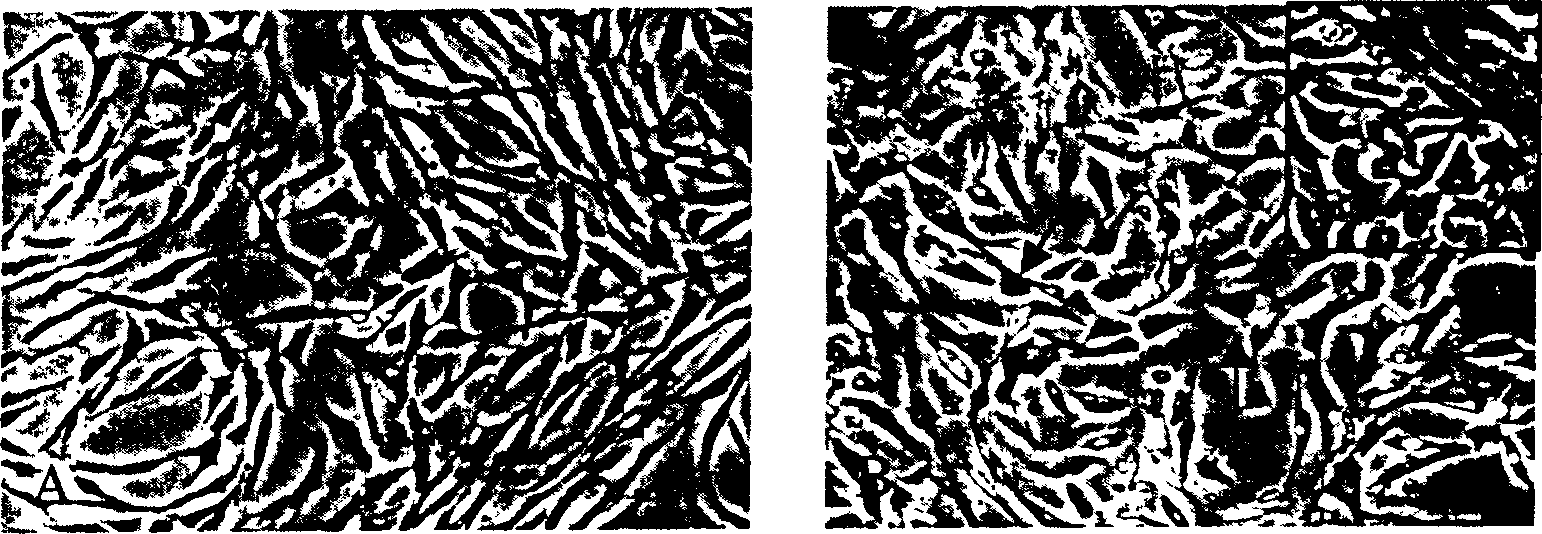Method for inducing fibroblast to form cartilage cells
A technology for fibroblasts and chondrocytes, which is applied in the fields of biology and tissue engineering, and can solve problems such as making chondrocytes
- Summary
- Abstract
- Description
- Claims
- Application Information
AI Technical Summary
Problems solved by technology
Method used
Image
Examples
Embodiment 1
[0085] Fibroblast culture and passaging
[0086]Under sterile conditions, the skin and dermis tissue excised during circumcision was taken, cut into pieces and transferred to a centrifuge tube, and digested by adding 0.1% type I collagenase (WORTHINGTON company) about 10 times the volume of the tissue, at 37°C for 2 hours, After filtering with a 100-mesh cell strainer, centrifuge at 1000 rpm for 5 minutes, discard the supernatant, add 10% FBS DMEM culture solution (GIBCO) to mix the cells, and dilute the cells at 2×10 4 / cm 2 Inoculated in 100mm culture dish (FALCON, FranklinLakes NJ) for culture, when the cells were confluent to 80%-90%, subcultured, the subculture density was 1×10 4 / cm 2 . After in vitro expansion to the second generation, the experimental grouping was carried out.
Embodiment 2
[0088] Induction of Chondrocytes in Monolayer Culture
[0089] In this example, chondrocytes were induced by monolayer culture cell induction method. Methods as below:
[0090] Dilute CDMP1 growth factor (Research Diagnostics) to 100 μg / ml with 0.1% BSA, add F-12 (Gibco Company) culture solution containing 10% FBS to make the final concentration 100 ng / ml, and prepare cell induction solution. The second-generation fibroblasts were inoculated for 6-12 hours, and the cells were induced. The culture medium was changed every three days, and the induction was carried out for 7 days (at 37°C, 5% CO 2 , saturated humidity), and isolated to obtain chondrocytes.
Embodiment 3
[0092] Centrifuge Tube Culture Cell Induction
[0093] In this example, chondrocytes were induced by monolayer culture cell induction method. Methods as below:
[0094] The preparation of the induction solution was the same as in Example 2. Collect the fibroblasts that have been passaged to the 6th passage and centrifuge at 1500 rpm for 5 minutes, discard the supernatant, add cell induction solution, shake the cell mass, induce for 7 days, and obtain the chondrocyte mass.
[0095] Paraffin-embedded and sectioned for identification by Masson's Trichrome, Alcian Blue and immunohistochemical staining.
PUM
 Login to View More
Login to View More Abstract
Description
Claims
Application Information
 Login to View More
Login to View More - R&D
- Intellectual Property
- Life Sciences
- Materials
- Tech Scout
- Unparalleled Data Quality
- Higher Quality Content
- 60% Fewer Hallucinations
Browse by: Latest US Patents, China's latest patents, Technical Efficacy Thesaurus, Application Domain, Technology Topic, Popular Technical Reports.
© 2025 PatSnap. All rights reserved.Legal|Privacy policy|Modern Slavery Act Transparency Statement|Sitemap|About US| Contact US: help@patsnap.com



